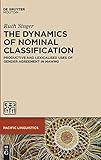The Dynamics of Nominal Classification : Productive and Lexicalised Uses of Gender Agreement in Mawng / Ruth Singer.
Material type: TextSeries: Pacific Linguistics [PL] ; 642Publisher: Berlin ; Boston : De Gruyter Mouton, [2016]Copyright date: ©2016Description: 1 online resource (268 p.)Content type:
TextSeries: Pacific Linguistics [PL] ; 642Publisher: Berlin ; Boston : De Gruyter Mouton, [2016]Copyright date: ©2016Description: 1 online resource (268 p.)Content type: - 9781614514244
- 9781501501203
- 9781614513698
- 499/.15 23
- online - DeGruyter
- Issued also in print.
| Item type | Current library | Call number | URL | Status | Notes | Barcode | |
|---|---|---|---|---|---|---|---|
 eBook
eBook
|
Biblioteca "Angelicum" Pont. Univ. S.Tommaso d'Aquino Nuvola online | online - DeGruyter (Browse shelf(Opens below)) | Online access | Not for loan (Accesso limitato) | Accesso per gli utenti autorizzati / Access for authorized users | (dgr)9781614513698 |
Frontmatter -- Acknowledgements -- Table of contents -- List of figures -- List of tables -- Abbreviations and glossing conventions -- 1. Introduction -- 2. Theoretical issues -- 3. Grammatical sketch -- 4. Gender -- 5. Restricted argument verbs: verbs with very narrow selectional restrictions -- 6. Lexicalised agreement -- 7. A typological perspective on Mawng verbs with non-canonical agreement -- 8. Conclusions: towards a more dynamic understanding of nominal classification and its lexicalisation -- Bibliography -- Appendix 1: Pronominal prefixes -- Appendix 2: Wurakak ‘Crow’ text (AD Text 1) -- Appendix 3: Full list of the 28 language sample -- Appendix 4: Email sent to language experts for survey of lexicalised agreement -- Appendix 5: Full list of all non-canonical verbs recorded in Mawng -- Appendix 6: Sources of Mawng material -- Author index -- Subject index -- Language index
restricted access online access with authorization star
http://purl.org/coar/access_right/c_16ec
The use of grammatical gender in the Australian language Mawng calls into question prevailing ideas about the functions of nominal classification systems. Mawng’s gender system has a strong semantic basis and plays an important role in the construction of meaning in discourse. Gender agreement in verbs is frequently lexicalized, creating idioms called lexicalised agreement verbs that are structurally similar to noun-verb idioms. This book will be of interest to anyone interested in nominal classification or cross-linguistic approaches to idioms.
Issued also in print.
Mode of access: Internet via World Wide Web.
In English.
Description based on online resource; title from PDF title page (publisher's Web site, viewed 25. Jun 2024)


